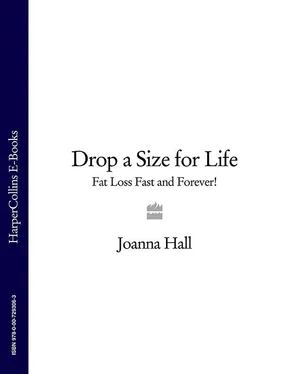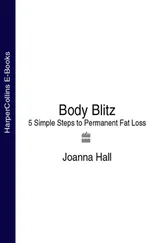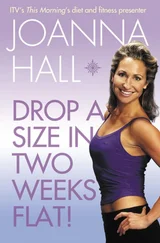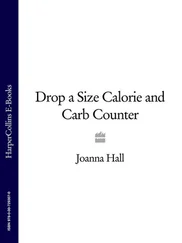This repeated cycle of failure creates self-fulfilling prophecies. In other words, because you’ve failed before, you expect to fail again right from the outset, so you embark on your weight loss regime with ‘I bet this doesn’t work’ in the back of your mind. With this mindset, failure is hardly surprising – and of course having proved that you are a failure, your self-esteem and confidence are further undermined.
This can actually have a negative effect on how you see yourself – on your body image. Research has shown that women who have low self-esteem have a less accurate picture of what their bodies look like than women who are more confident about themselves. Unfailingly, the under-confident women see themselves as larger than they are in reality. So not only does repeating the same mistakes fail to produce results, it may also make you feel worse than you did at the start of the whole process!
Dropping a size for life is about putting an end to this negative cycle of behaviour. This involves learning how to target your efforts to where they’ll really count and about forging and nurturing a positive relationship between your body and your brain. Losing weight isn’t physically hard. You know what you have to do – eat less and exercise more! However, to keep that weight off, you will need to learn how to develop mental strategies and the right mindset so that you can tackle all the challenges that life throws at us – whether it’s life stages such as pregnancy, the physical effects of growing older, dealing with different emotional situations, or coping with all those everyday crises that seem to be an integral part of life in the 21st century.
GETTING STARTED CONTENTS Introduction Getting Started How the book works Section One: Preparing to Drop a Size Step 1 Train your brain Step 2 Befriend the mirror Step 3 Think, say and do as one Step 4 Make friends with the enemy Step 5 Establishing the here and now Step 6 Get on that pedestal Step 7 Finding the elusive G spot Section Two: Dropping that Size The 10 Fundamentals Follow the Carb Curfew Eat more fibre Cut your sodium intake Fit in some exercise – with and without your trainers Get savvy about fats Don’t skimp on the protein Beware of alcohol – the hidden pound piler Keep up your water intake Get to grips with portion control Follow the 80-20 rule The drop a size eating plans The Recipes Drop a size for life foods Troubleshooting some commonly asked questions and problems Section Three: Keeping Your New Size for Life The child-bearing years Pregnancy Reclaiming your body after pregnancy Midlife Perimenopause Menopause Growing older by the same author Copyright JOANNA HALL About the Publisher
WHAT IS THE RIGHT SIZE?
The old adage ‘you can never be too rich or too thin’ is one that is held in much too high a regard in our society. Of course you can be too thin and striving for a size that is not realistically achievable is not only a soul-destroying business, it’s also a dangerous game. You’re dicing with your health and are at risk of developing disordered eating behaviours or even a full-blown eating disorder.
So what is the right size? Well judging from a recent survey, which revealed that 63 per cent of people lie about their weight, with 22 per cent not even telling their partner, most of us think it’s smaller than whatever size we are! Realistically, the majority of us know when we’ve put on a few too many pounds, and have a clothes size we secretly hanker after or have something hanging in our wardrobe that we’d really like to fit into again one day. This plan is geared towards dropping a clothes size, but it can still work for you if you need to drop more than one size – provided you stay with it for long enough. And if you are significantly overweight – and more than half the UK population is now classified as such – you’ll be doing yourself a huge favour by taking steps to lose those excess pounds.
Obesity is now recognized as a serious medical condition with many associated health risks, including heart disease, hypertension, diabetes, gallstones, osteo-arthritis of weight-bearing joints, sleep apnoea, reproductive disorders and some cancers. Professor Philip James, chairman of the Obesity Task Force, describes obesity as ‘the biggest global health burden for the world’. And while the UK may lag behind the US in rates of obesity, we’re gaining ground rapidly. In 1980, the average British man weighed 73.7kg; for a woman the average was 62.2kg. By 2000, those figures had increased to 81.6kg and 68.8kg respectively.
ASSESSING YOUR BODY MASS INDEX (BMI)
BMI is a simple way of assessing your body weight status. It’s not foolproof, however, as it does not distinguish between fat and muscle. It’s also not a good measure of progress as you get fitter, as increased muscle mass may actually make you heavier rather than lighter, although you will be substantially fitter and trimmer and slipping into a smaller clothes size.
Use the formula below to determine your BMI and then check this against the BMI categories to see whether you are already a healthy body weight or if you have a more significant amount of body fat to lose.
To obtain you BMI, measure your weight in kilograms and your height in metres and then divide your weight by your height squared: W/H 2= BMI.
For example, if you weigh 63kg and are 1.70m tall, you multiply 1.7 by 1.7 to give you 2.89, then divide 63 by 2.89. This gives a BMI of 21.79, which, as you can see from the categories on page 8, would put you within the normal weight range. (If you want to make life easy, you can calculate your BMI automatically without having to do the maths at my website www.joannahallonline.com)
Underweight = under 20
Normal weight = 20–24.9
Overweight = 25–29.9
Obese = 30+
Although BMI has been widely used since the 1980s to estimate body shape change and the risk of various obesity-related diseases, using the waist circumference measurement is simpler and has been shown to indicate obesity-related risks just as well as BMI. Developed by an expert panel on obesity and health risks, the waist circumference method of indicating health risk classifies a healthy waist circumference as being below 102cm/40in for men and 88cm/34in for women.
As well as being simple, the waist circumference measurement also gives a more accurate picture of an individual’s body fat distribution. And since the Drop a Size for Life plan is concerned not solely with measuring weight on the scales but more with clothes size, girth measurements are the best way to monitor your progress as you follow this plan.
TAKING YOUR GIRTH MEASUREMENTS
The charts opposite shows the usual measurements that are taken – if you wish you can use it to record you own details when you begin the plan. The body fat measurement is not essential but it is helpful. Body fat can be measured using skin fold calipers or, more conveniently, using a body fat monitor – these are similar to bathroom scales but they determine your percentage body fat, giving a truer idea of what is going on in your body.
| For Women: |
|
| Weight |
|
| Body fat (if known) |
|
| Chest |
|
| Waist |
|
| Navel |
|
| Hips |
|
| Thighs |
|
| For Men: |
|
| Weight |
|
| Body fat (if known) |
|
| Chest |
|
| Waist with belly button contracted |
|
| Waist with belly button relaxed |
|
| Hips |
|
| Thighs |
|
Читать дальше












